Here’s How To Plant And Care For Caladium Including Where To Keep It In Your Home

HOUSEPLANTS > CALADIUM

Elizabeth is a Permaculture Garden Designer, Sustainability Consultant and Professional Writer, working as an advocate for positive change. She graduated from the University of St. Andrews with an MA in English and Philosophy and obtained a Diploma in Applied Permaculture Design from the Permaculture Association.
Reviewed By ROY NICOL

Roy is a Professional Gardener and Horticultural Consultant, specialising in large garden year-round maintenance and garden development. He is an RHS Master of Horticulture and uses his research in the application of no-dig methods in ornamental garden settings. Roy has been a Professional Gardener for more than six years and is a member of the Chartered Institute of Horticulture, Professional Gardener's Guild and Association of Professional Landscapers (Professional Gardener).
IN THIS GUIDE
CALADIUM GUIDES
Caladiums are commonly grown as ornamental plants, valued for their large arrow-shaped leaves which have varied patterns on the leaves that appear in white, pink and red.
In the UK, caladiums are usually grown as houseplants or as tender tubers in the garden through the summer months.
They are highly prized for their ornamental appeal, both when grown indoors and when used outdoors in the garden.
Overview
| Botanical Name | Caladium |
| Common Name(s) | Angel Wings |
| Plant Type | Houseplant |
| Native Area | Southern & Central America |
| Hardiness Rating | H1B |
| Foliage | Deciduous |
| When To Plant | Spring (if growing outdoors) |
| When To Prune | Year-round when needed |
Sunlight
Preferred
Full Shade or Partial Shade
Exposure
Sheltered
Size
Height
0.5 – 1M
Spread
0.1 – 0.5M
Soil
Preferred
Loam or sand
Moisture
Moist but well-drained
pH
Any
This genus of plants in the family Araceae are commonly called ‘Angel Wings’, ‘Elephant Ears’ and ‘The Heart of Jesus’.
There are over 1,000 named cultivars of caladium, all of which come from the original plant.1Caladium (Angel Wings, Caladium, Elephant’s Ear). (n.d.). North Carolina Extension Gardener Plant Toolbox. Retrieved May 2, 2023, from https://plants.ces.ncsu.edu/plants/caladium/
There are 19 species within the genus (according to the Accepted Species listed by Kew) and all of these are native to South and Central America – and naturalised elsewhere in tropical climes.2Caladium. (n.d.). Kew Royal Botanic Gardens. Retrieved March 13, 2023, from https://powo.science.kew.org/taxon/urn:lsid:ipni.org:names:30005919-2
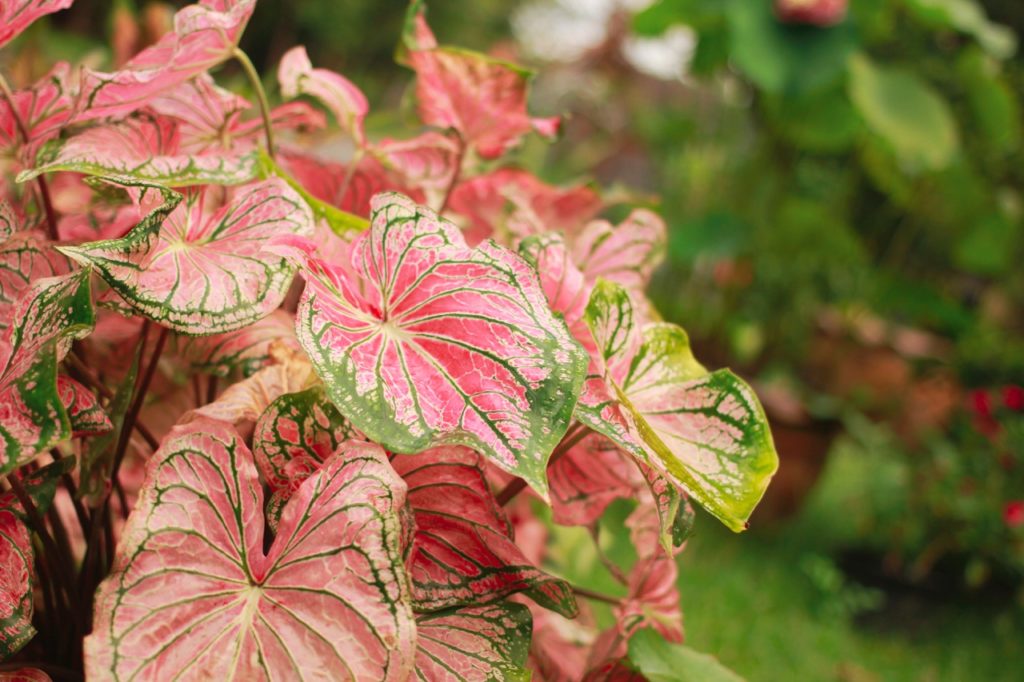
Caladiums have been in cultivation in Europe since the mid 18th century, though when grown here in the UK, they do not tend to grow to the same size as they do in the tropics.3Deng, Z. (2018). Caladium. Springer EBooks, 273–299. https://doi.org/10.1007/978-3-319-90698-0_12
They usually grow to a maximum of around 60cm high and wide, though there are also smaller dwarf cultivars which are now available.
Common Varieties
Some varieties of caladium to consider growing in the UK are:
C. ‘Aaron’
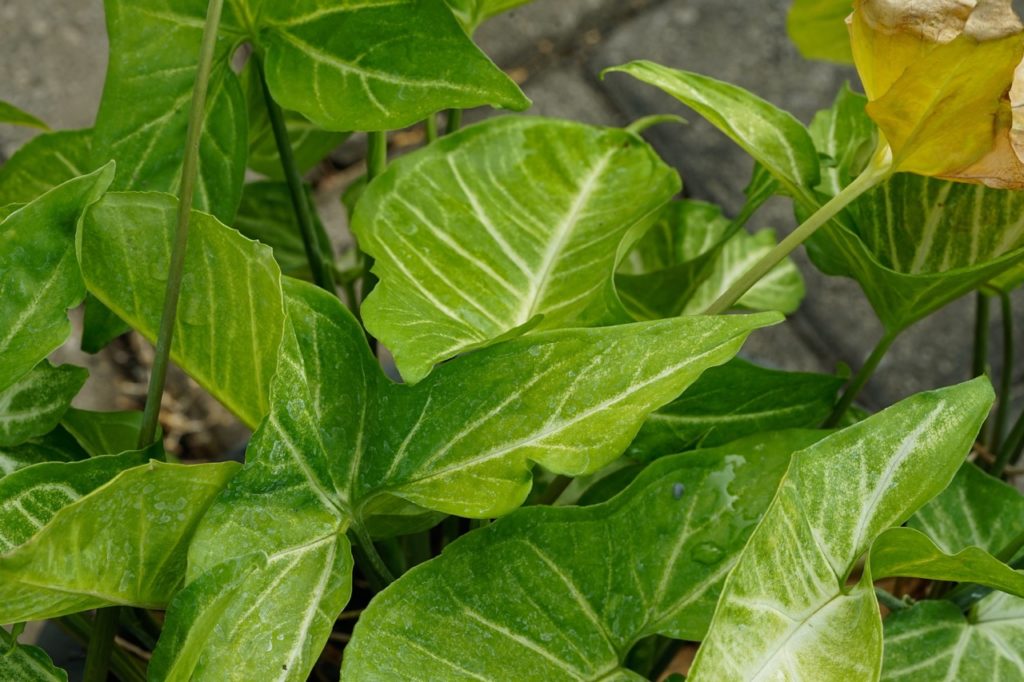
C. ‘Carolyn Whorton’
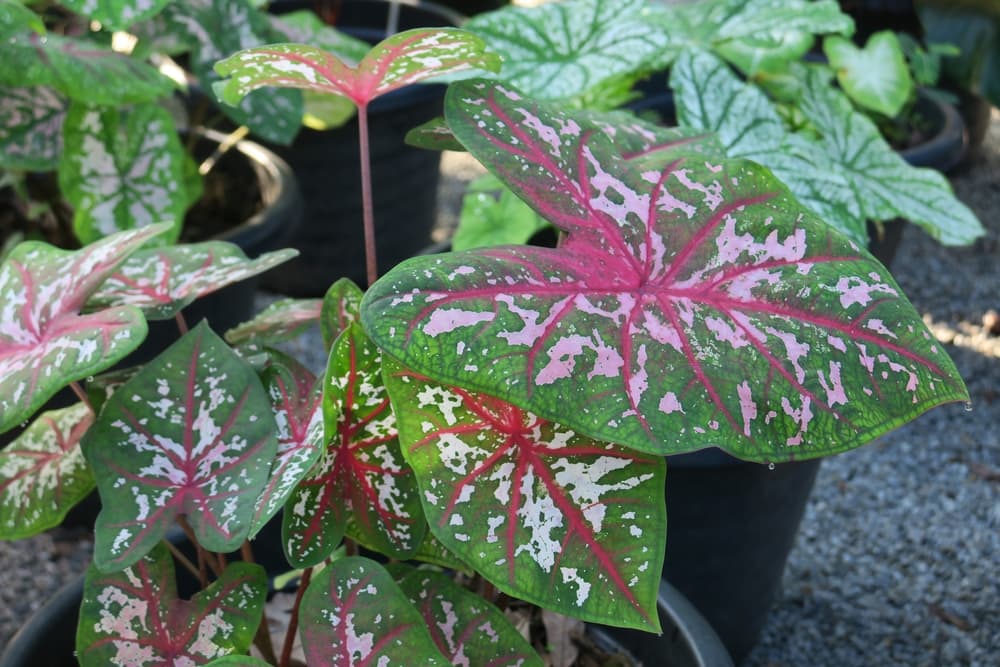
C. ‘Galaxy’
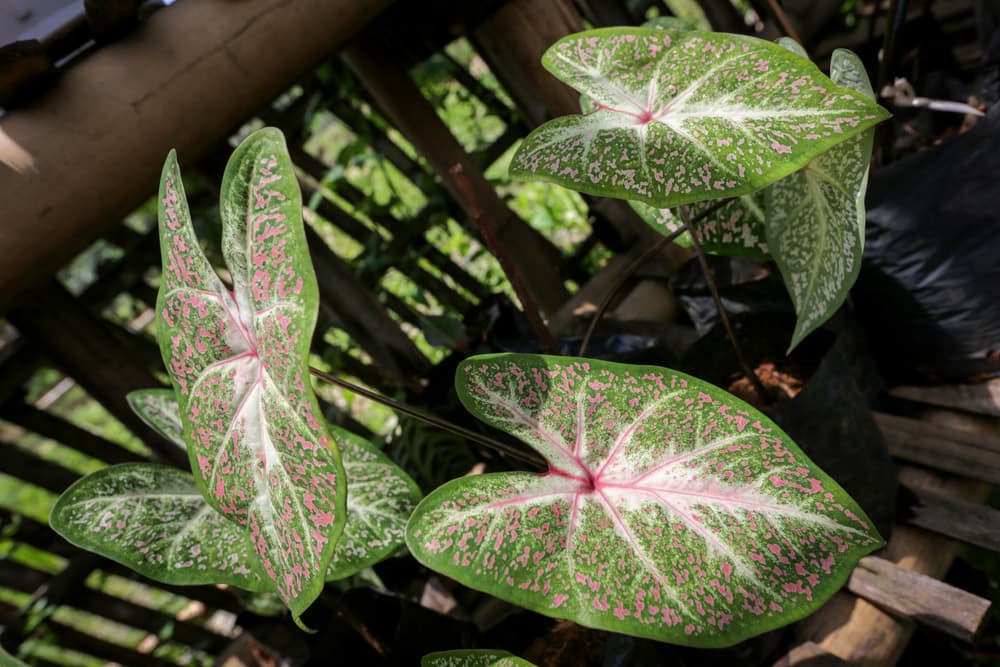
C. ‘Red Flash’

C. ‘White Queen’
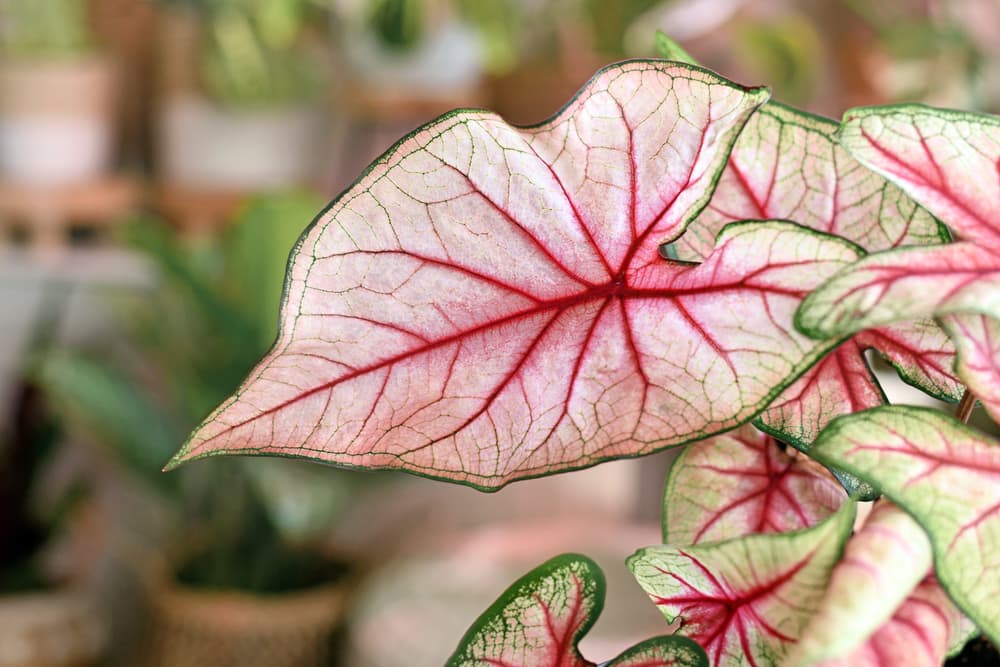
And some other popular varieties to explore:
- C. ‘Cranberry Star’
- C. ‘Festivia’
- C. ‘Florida Elise’
- C. ‘Frog in a Blender’
- C. ‘Rosebud’
- C. ‘Sizzle’
- C. ‘Spring Fling’
Where To Grow Caladium
Caladium thrives in partial shade in the UK where it receives a maximum of 2 hours of direct sun, but most cultivars grow reasonably well in full shade.
They do best in moist and rich but well-draining soil when grown outdoors and will appreciate a sheltered site.
Caladium tubers can only be grown outdoors year-round in very warm parts of the British Isles, with sheltered and warm micro-climates.
However, they can also be grown outdoors over the summer months in cooler spots, as long as they are provided with appropriate growing conditions and lifted and stored before temperatures are consistently below 10°C and certainly before the first frosts.
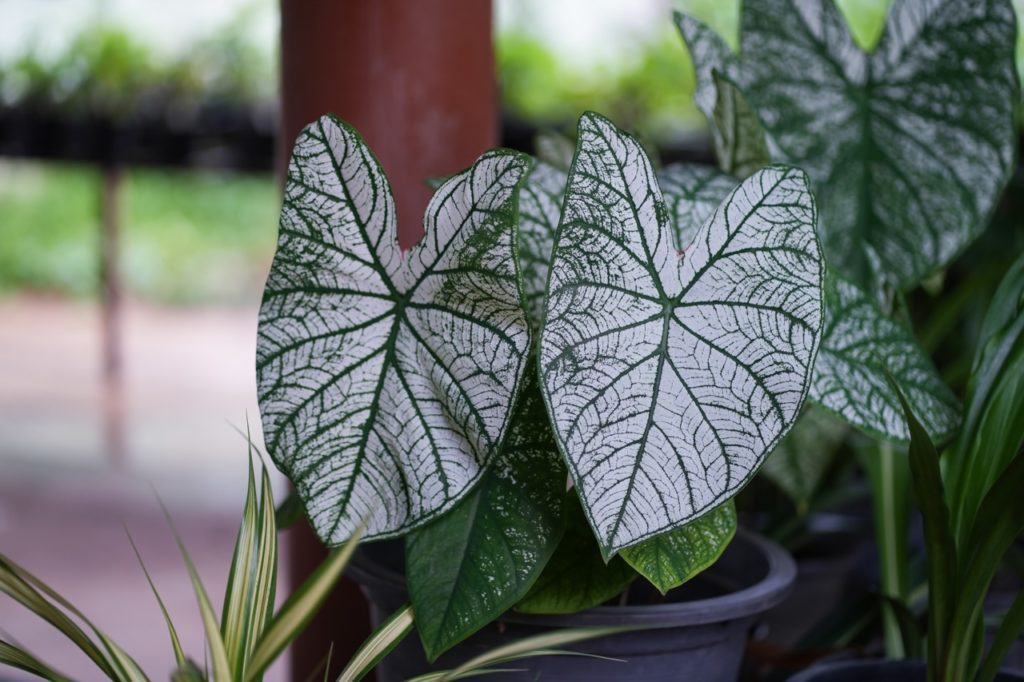
Most UK gardeners will choose to grow caladiums in containers, which can be kept indoors year-round or moved under cover before frost threatens.
If growing caladium indoors, you should plant in a peat-free multipurpose compost or DIY equivalent, with reasonably good drainage but also reasonably good water retention.
The container should be at least 15cm deep, wide enough to accommodate the tuber and allow for some root expansion.
It should be placed in a location which receives good light but is out of direct sunlight.
Planting Caladium
Caladium bulbs should be started indoors or in a greenhouse in pots in the early spring, usually around 4-6 weeks before all risk of frost has passed in your area.
The tubers should be planted so that the growing tip is approximately 5cm below the surface of the growing medium.
The compost should be watered sparingly at first and kept at around 20°C to encourage the tubers to wake from their dormant winter phase.
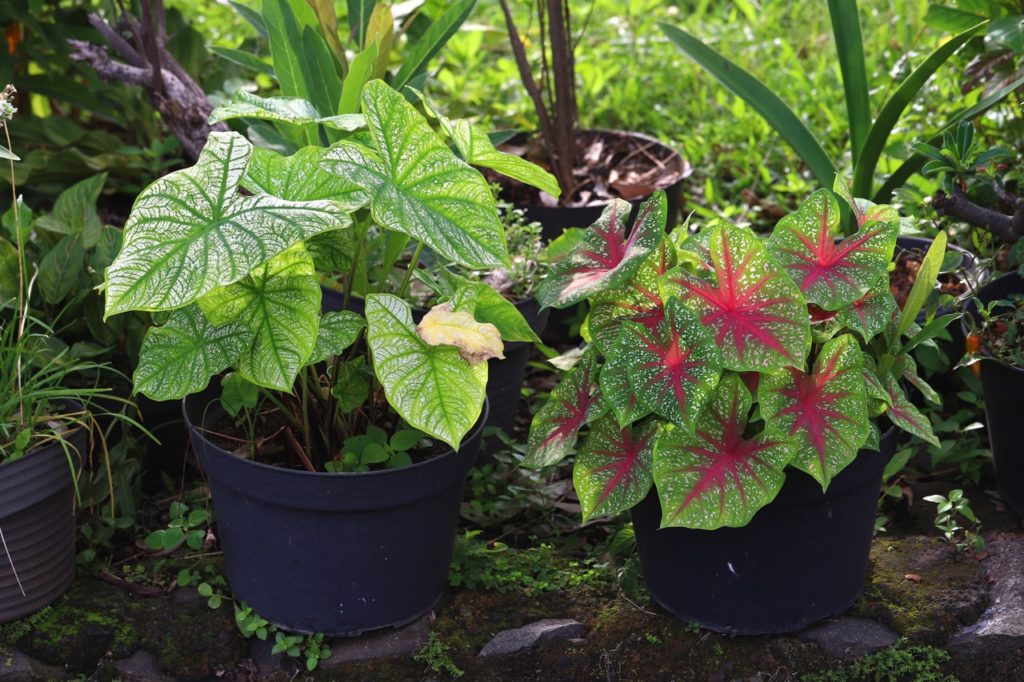
If you are planting caladium in a suitable spot outdoors, you should do so once any risk of frost has passed and outdoor temperatures are warm.
Dig holes between 5-8cm deep and place a tuber in each one, covering them over with soil.
You can also transfer indoor-grown caladium tubers to your garden at this time, taking care to position the container in a suitable shaded spot.
Companion Planting
Caladiums can be susceptible to aphids and other sap suckers.
When growing them outdoors, it may be helpful to add companion plants close by which will attract beneficial insects that can help keep down the populations of aphids and other pests.
Angelica, dandelion, feverfew, dill and fennel are just a few examples.
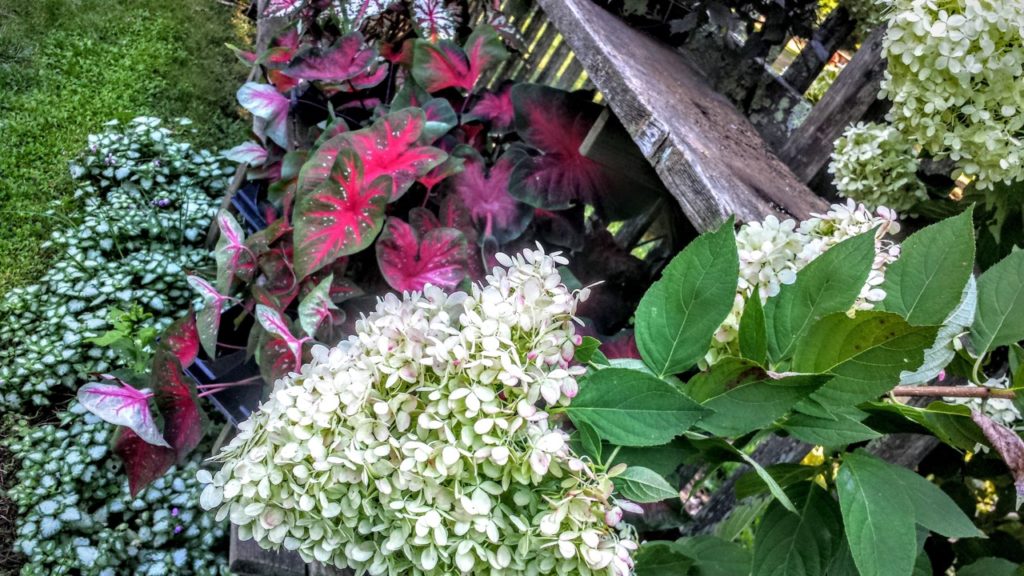
To create attractive ornamental schemes, you might grow caladiums alongside other partial shade lovers which add further flowers or interesting foliage, like hydrangeas, hostas, begonias, hellebores, impatiens, convallarias and lamiums.
Of course, combining various different caladiums in containers or in the ground can also help you to achieve an attractive display, since there are so many different variants in terms of colour and size to choose from.
Caladium Plant Care
Watering
Caladiums require regular watering over the summer months when grown in containers, but are unlikely to require additional water when grown in the ground unless there is a prolonged period of drought.
When watering container-grown plants, make sure that you keep the soil moist, but take care not to overwater and ensure that the container and medium are allowing the water to drain relatively freely.
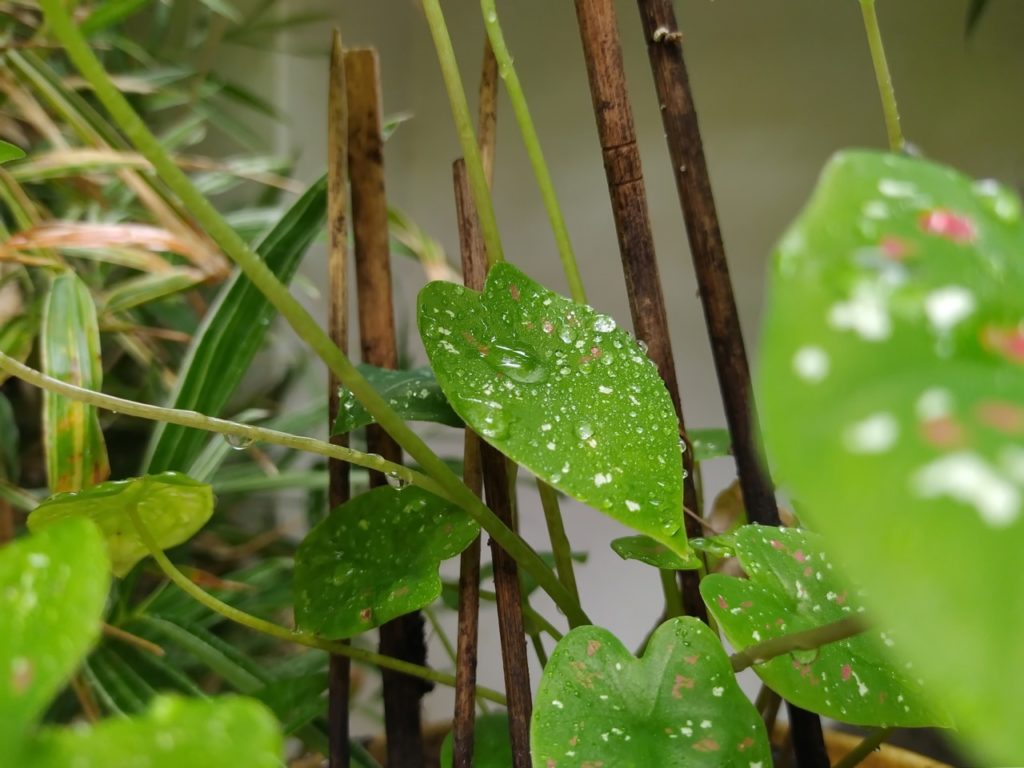
Curtail watering significantly as winter approaches and only water when the growing medium is dry over the colder months.
Over the summer months, it is also a good idea to mist caladium leaves regularly with calcium-free water.
Caladiums like a humid environment and an indoor location can sometimes be rather dry.
Feeding
Mulch around caladiums growing outdoors with good quality compost or other organic matter to provide slow-release fertility.
Plants grown in containers will also benefit from watering with a balanced organic liquid fertiliser once a month, which will help to keep the plants happy and healthy.
Winter Care
If you are growing caladium in containers indoors, wait until the leaves die back naturally.
When they do, simply leave the caladium bulb in the container and store it for next season at temperatures between 13-16°C.
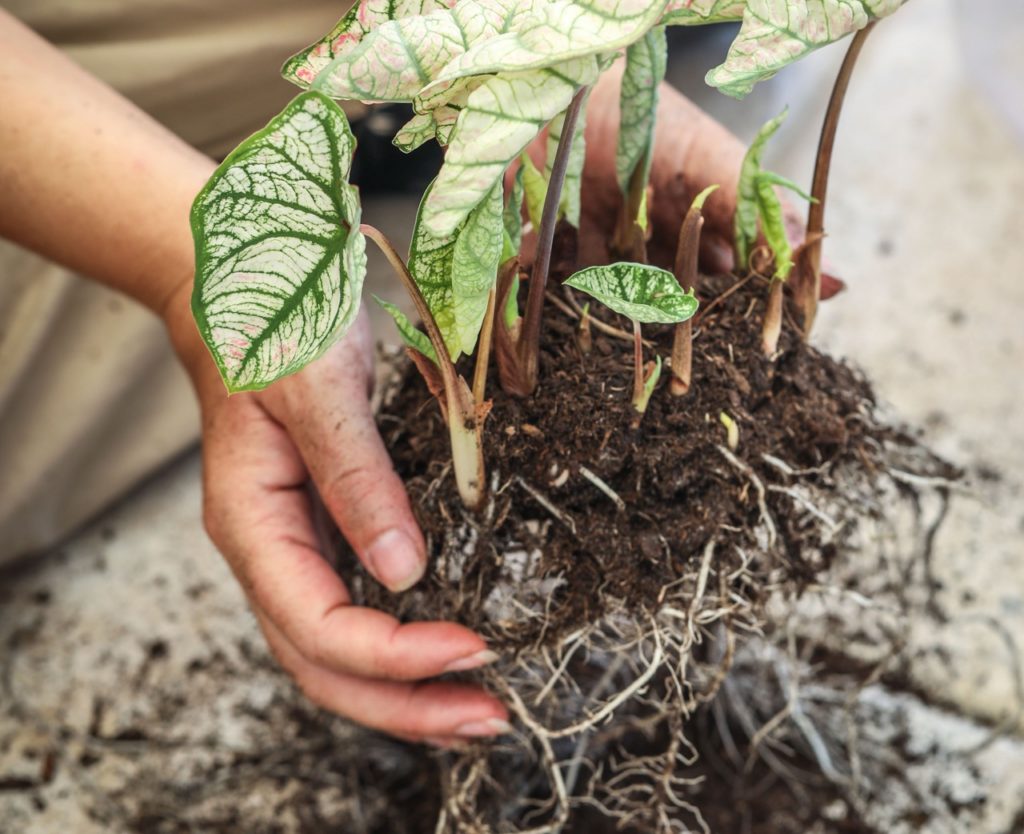
If growing outdoors in all but the warmest regions, bulbs should be lifted and brought indoors before the first frosts.
These bulbs should also be stored at between 13-16°C until they are planted again the following year.
Repotting
Caladiums will generally need repotting every 2-3 years, ideally in spring.
Caladium plants do require some careful care, especially when grown indoors, but if you can care for them successfully, they can be attractive plants to have around.
References
- 1Caladium (Angel Wings, Caladium, Elephant’s Ear). (n.d.). North Carolina Extension Gardener Plant Toolbox. Retrieved May 2, 2023, from https://plants.ces.ncsu.edu/plants/caladium/
- 2Caladium. (n.d.). Kew Royal Botanic Gardens. Retrieved March 13, 2023, from https://powo.science.kew.org/taxon/urn:lsid:ipni.org:names:30005919-2
- 3Deng, Z. (2018). Caladium. Springer EBooks, 273–299. https://doi.org/10.1007/978-3-319-90698-0_12
